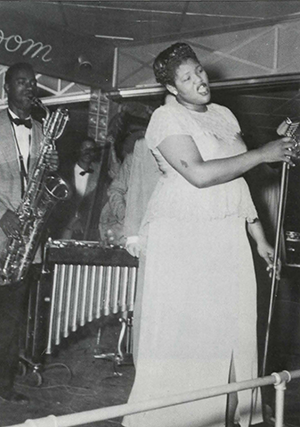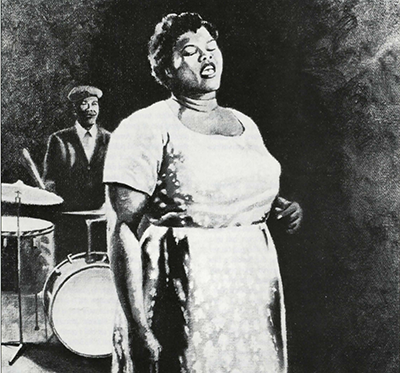"Hound Dog" belonged originally to a rhythm and blues singer, named Willie Mae Thornton, who, at the time of Elvis's recording, was making her living on what Black entertainers called "The Chitlin' Circuit." She had a big voice and suitably imperious manners, all of which had given rise to a nickname that had quickly supplanted her given name. On her rendition of "Hound Dog," released as a 78 rpm record, she was billed as "Big Mama" Thornton.
"Big Mama's" version of "Hound Dog," recorded for Peacock Records on a hot August day in 1952 in Los Angeles, was the crowning achievement in the career of a singer who left her mark on rock and blues history. "Hound Dog" quickly climbed to No. 1 on the 1953 all-Black rhythm and blues charts and became a 500,000-plus seller. It also became by far the biggest success in Willie Mae Thornton's career.
 "Big Mama" Thornton performed with Johnny Otis throughout much of her career. [Photo/Johnny Otis]
"Big Mama" Thornton performed with Johnny Otis throughout much of her career. [Photo/Johnny Otis] "Big Mama" started making records for Peacock in 1951. The first recordings were noisy, brash affairs--but seasoned with Big Mama's down-home voice, and an occasional dose of worldly humor in the lyrics. Some of the titles included "Cotton Picking Blues," "All Fed Up," and "Mischievous Boogie"; later, "Big Mama" recorded songs that reflected more of her personality: "I Smell a Rat," and "I Ain't No Fool, Either." These were mainly local sellers. Recorded with an eight-piece combo of horns and rhythm, they helped keep her name in circulation.
A recording session for Peacock in Los Angeles on August 13, 1952, however, seemed tailor-made for “Big Mama's” talents. The backing group, stripped of the horns, was boiled down to a tough, gritty rhythm section, sparked by the sizzling guitar of Pete Lewis. “Big Mama”, fresh from performing, was, as they say, in voice. And she had a song she could sink her teeth into. It was "Hound Dog," the product of a team of white writers, Jerry Leiber and Mike Stoller.
Invigorated by her hot backup band, “Big Mama” gave the song a superb reading, laced with humor and irony. She sang the lyrics--"You ain't nothing but an ole hound dog, Quit snoopin' round my door"--as if she had her hands on her hips; she even threw in a few mocking howls for good measure. Far too raw for white ears attuned to the fluffy pop of the early 1950s hit parade, the record was a smash in the Black communities, where it rang hard and true.
"Hound Dog" was “Big Mama” Thornton's only chart hit. It entered the Black playlists in March of 1953 and remained there for fourteen weeks, soaring to No. 1. For “Big Mama”, "Hound Dog" is reported to have sold more than 500,000 copies, taking the fire-engine red Peacock label into Black houses from coast to coast.
Though nothing again came near the success of "Hound Dog" for “Big Mama”, the record carried her as a performer for the next few years. In March 1953, she began touring in a three-star package with Junior Parker and Johnny Ace.
“Big Mama's” fortunes suffered no such dramatic reversal, but she was headed on her own downhill course. Fame had hovered close when Elvis, dipping into the musical reservoir of Black sounds he had heard as a teenager, resurrected "Hound Dog" for his 1956 recording. Elvis's version, epitomized by his goofy performance on the Steve Allen Show, became a goofy piece of musical nonsense sung to a real dog. It worked as rock and roll, but its hard rhythm and blues background was lost, as was Willie Mae Thornton's shot at the white record charts.
Looking on from the sidelines, “Big Mama” was not amused. "That song sold over two million records," she said. "I got one check for $500 and I never saw another." It was the start of a long slide for “Big Mama”, who was to have only a brief return encounter with fame.
She toured with Gatemouth Brown in 1956 and settled down in the Bay Area the next year, where she worked a variety of clubs and tried without success to duplicate her 1952 hit. But music was changing. Big mamas with raw country voices and raucous ways were on the way out; smooth-sounding pop-ish balladeers and high-voiced girl singers were on the way in. It was a bad time for the blues. Though a small, hard-core audience for “Big Mama's” music existed--it would continue to exist through thick and thin.
Later on, musical icon Janis Joplin saw Thornton perform; in fact, Joplin studied “Big Mama's” live performances in Venice and San Francisco, and she seldom hesitated to give credit to her inspiration to writers who were thoughtful enough to ask. As a further bow, Joplin performed her version of a composition by “Big Mama”, "Ball and Chain," on Big Brother's smash 1968 "Cheap Thrills" record. Ironically, the song came to be identified strongly with Joplin, though the royalties it brought “Big Mama” were not inconsiderable.
By the early 1980s, Willie Mae Thornton had slipped into relative obscurity. On July 25, 1984, she passed away, the victim of heart and liver trouble. She was fifty-seven.
“Big Mama” Thornton, the singing preacher's daughter from Montgomery, never sang to a hound dog. She did things her way. Her voice may have failed, her body may have faded away, but she died with her immense pride intact. "I always kept a smile on my face," she said in a telling interview late in her career. "They didn't know what was going through my mind. Didn't have nothing to eat. They didn't know. Didn't have nowhere to stay. They didn't know."
This feature was previously published in Issue 6, Fall 1987. Due to Issue 6 being out of print, an excerpt of this story is provided for free.

 RSS Feed
RSS Feed